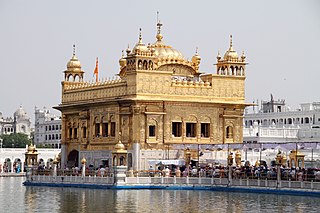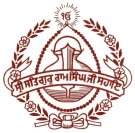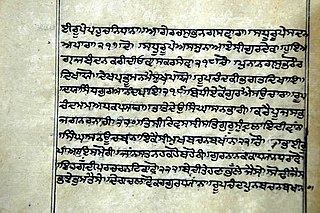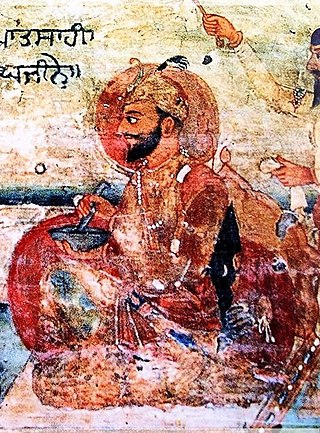
Sikhism, also known as Sikhi, is an Indian religion and philosophy in particular for the Sikh ethnoreligious group that originated in the Punjab region of India around the end of the 15th century CE. The Sikh scriptures are written in the Gurumukhi script particular to Sikhs. It is one of the most recently founded major religious groups and among the largest in the world, with about 25–30 million adherents.

Khalsa refers to both a community that considers Sikhism as its faith, as well as a special group of initiated Sikhs. The Khalsa tradition was initiated in 1699 by the Tenth Guru of Sikhism, Guru Gobind Singh. Its formation was a key event in the history of Sikhism. The founding of Khalsa is celebrated by Sikhs during the festival of Vaisakhi.

The Dasam Granth is a collection of various poetic compositions attributed to Guru Gobind Singh. The text enjoyed an equal status with the Adi Granth, or Guru Granth Sahib, in the eighteenth and nineteenth centuries and were installed side by side on the same platform. The Dasam Granth lost favor during the colonial period when reformist Singh Sabha Movement scholars couldn't contextualize the reworkings of Puranic stories or the vast collection of 'Tales of Deceit' Sri Charitropakhyan.

The Nihang or Akali, also known as Dal Khalsa, is an armed Sikh warrior order originating in the Indian subcontinent. Nihangs are believed to have originated either from Fateh Singh and the attire he wore or from the "Akal Sena" started by Guru Hargobind. Early Sikh military history was dominated by the Nihang, known for their victories where they were heavily outnumbered. Traditionally known for their bravery and ruthlessness in the battlefield, the Nihang once formed the irregular guerrilla squads of the armed forces of the Sikh Empire, the Sikh Khalsa Army.

Anandpur Sahib, also referred simply as Anandpur, is a city in Rupnagar district (Ropar), on the edge of Shivalik Hills, in the Indian state of Punjab. Located near the Sutlej River, the city is one of the most sacred religious places in Sikhism, being the place where the last two Sikh Gurus, Guru Tegh Bahadur and Guru Gobind Singh, lived. It is also the place where Guru Gobind Singh founded the Khalsa Panth in 1699. The city is home to Takhat Sri Kesgarh Sahib, the third of the five Takhts in Sikhism.

The Namdharis, also known as Kuka and Kukaism, are a Sikh sect that differs from mainstream Sikhs chiefly in that it believes that the lineage of Sikh Gurus did not end with Guru Gobind Singh (1666–1708), as they recognize Balak Singh (1797–1862) as the 11th Guru of the Sikh religion, thus continuing the succession of Sikh Gurus through the centuries from Guru Nanak Dev to the present day. The 12th Guru was Ram Singh (1816–1885), who moved the sects centre to Bhaini Sahib (Ludhiana) and is regarded as the first Indian to use non-cooperation and non-violence boycott in order to combat the British Empire in India.

The Sarbloh Granth or Sarabloh Granth, also called Manglacharan Puran or Sri Manglacharan Ji, is a voluminous scripture, composed of more than 6,500 poetic stanzas. It is traditionally attributed as being the work of Guru Gobind Singh, the tenth Sikh guru. Scholars, on the other hand, attribute the work to after the Guru's death, being authored by an unknown poet. The work is mostly revered by the Nihang sect.

Sakhi literally means 'historical account', 'anecdote', or 'story'. It is derived from the Sanskrit word sākṣī (साक्षी) which literally means 'witness'.
Guru Nanak founded the Sikh religion in the Punjab region of the northern part of the Indian subcontinent in the 15th century and opposed many traditional practices like fasting, janeu, idolatry, caste system, ascetism, azan, economic materialism, and gender discrimination.

Kahn Singh Nabha was a Punjabi Sikh scholar, writer, anthologist, lexicographer, and encyclopedist. His most influential work, Mahan Kosh, inspired generations of scholars after him. He also played a role in the Singh Sabha movement.

Ratan Singh Bhangu was a Sikh historian and Nihang who wrote about the Sikhs' struggles and rise to power in North India, in his book Prachin Panth Prakash. This work describes how the Sikh people came to dominate Punjab in the 1700s and remains one of the few historical accounts of the era.

Akali Phula Singh Nihang was an Akali Nihang Sikh leader. He was a saint soldier of the Khalsa Shaheedan Misl and head of the Budha Dal in the early 19th century. He was also a senior general in the Sikh Khalsa Army and commander of the irregular Nihang of the army. He played a role in uniting Sikh misls in Amritsar. He was not afraid of the British who at many times ordered for his arrest but were not successful. During his later years he served for the Sikh Empire as a direct adviser to Maharaja Ranjit Singh. He remained an army general in many famous Sikh battles up until his martyrdom in the battle of Nowshera. He was admired by the local people and had a great influence over the land and his settlement was always open to help the poor and helpless. He was well known and was a humble unique leader and prestigious warrior with high character. He was also known for his effort to maintain the values of Gurmat and the Khalsa panth.
A takht, or taḵẖat, literally means a throne or seat of authority and is a spiritual and temporal centre of Sikhism. There are five takhts, which are five gurudwaras that have a very special significance for the Sikh community. Three are located in Punjab whilst the remaining two are located outside of it.

Amrit Sanskar also called Amrit Parchar, Amrit Sanchar, Khande di Pahul, or Khande Batte di Pahul is one of the four Sikh Sanskaars. The Amrit Sanskar is the initiation rite introduced by Guru Gobind Singh when he founded the Khalsa in 1699.

Binod Singh, a Trehan Khatri and a descendant of Guru Angad, was an army man and disciple of Guru Gobind Singh and was among few Sikhs who accompanied him to Nanded in 1706. In Budha Dal Chronicles, Guru Gobind Singh made Baba Binod Singh the head of the Khalsa.

Twarikh Guru Khalsa is a historical book of the Sikhs from their origin to the time when they lost the Punjab to the British. The author of the book is Giani Gian Singh.

Sikh sects, denominations, traditions, movements, sub-traditions, also known as sampardai in the Punjabi language, are sub-traditions within Sikhism that believe in different approaches to practicing the religion. All sampradas believe in the One Creator God typically rejecting both idol worship and caste systems. Different interpretations have emerged over time, some of which have a living teacher as the leader. The major historic traditions in Sikhism, states Harjot Oberoi, have included Udasi, Nirmala, Nanakpanthi, Khalsa, Sahajdhari, Namdhari Kuka, Nirankari and Sarvaria.
Namdhari Guru Ram Singh is the second guru of the Namdhari sect of Sikhism. He is credited as being the first British Indian to use non-cooperation and boycott of British goods and services as a political tool. He was exiled to Rangoon, Burma (Myanmar) by the British colonial government of India on 18 January 1872.
A dera is a type of socio-religious organization in northern India. Jacob Copeman defines the deras as "monasteries or the extended residential sites of religious leaders; frequently just glossed as sect".

Panth Prakash, also called Pracīn Panth Prakash ["Old' Panth Prakash,not to be confused with "Naveen" Panth Prakash by Giani Gian Singh], is a historical text about Sikh history in the 1700s by Rattan Singh Bhangu and was completed in the early 1810s. The text's opening foundation briefly covers the lives of the ten Sikh Gurus, then traces the accomplishments of the Sikh community from 1708 to the establishment of Sikh rule in Punjab. The text provides the most comprehensive compilation of stories related to the feats of Sikh warriors in the 18th century, the evolving Sikh martial formations, and the internal power dynamics between Sikh Misl groups.

















